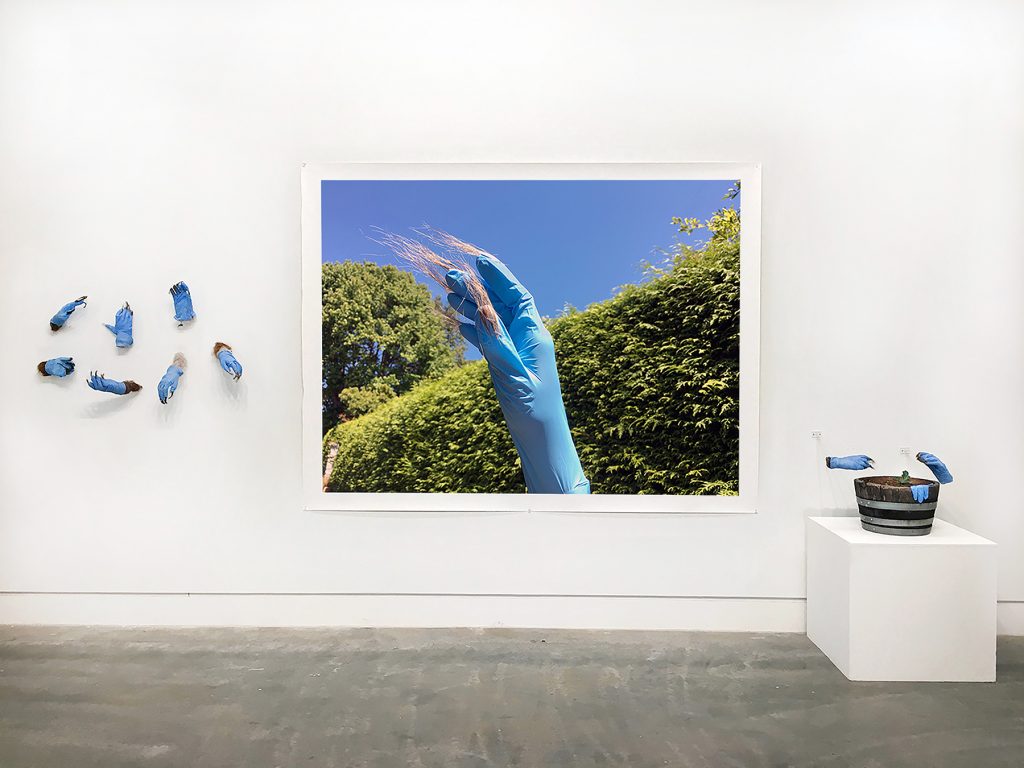
Carollyne Yardley, Sympoetics of Squirrealism (installation view), 2021. Mixed media, 18′ x 2′ x 8′. Installation in Becoming (Final Thesis Exhibition), Emily Carr University, 2021. Photograph by Carollyne Yardley.
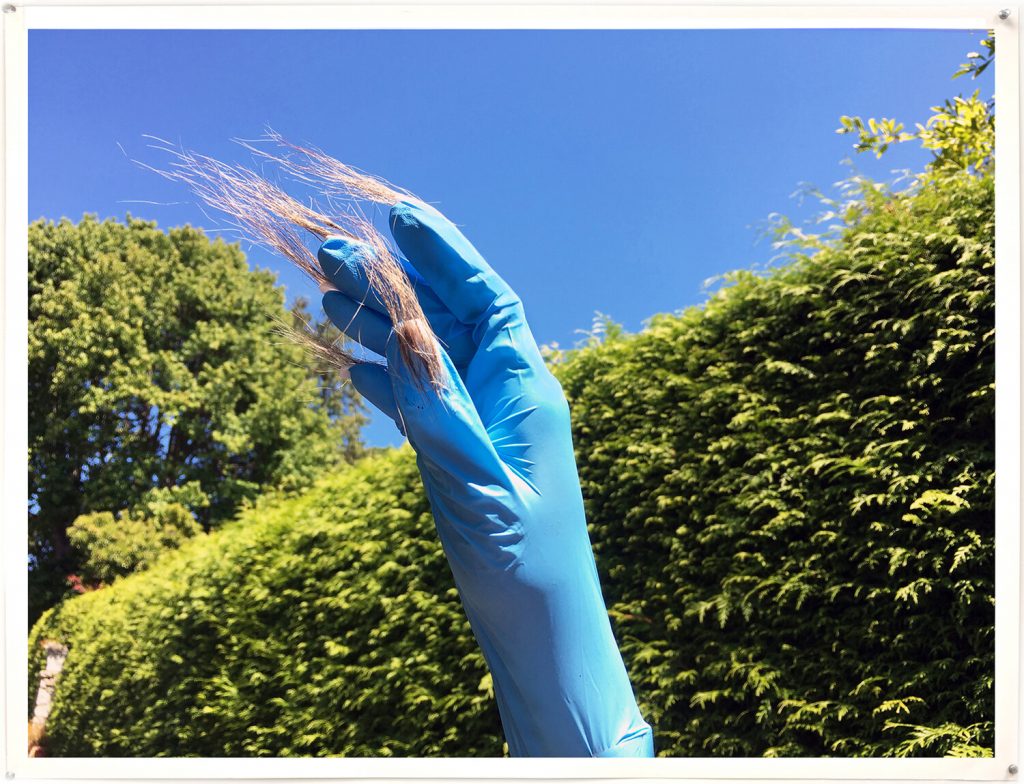
Carollyne Yardley, Becoming-with (detail), from the Sympoetics of Squirrealism series, 2021. Pigment on canvas, 78′′ x 60′′. Exhibited in Becoming (Final Thesis Exhibition), Emily Carr University, 2021. Photograph by Carollyne Yardley.
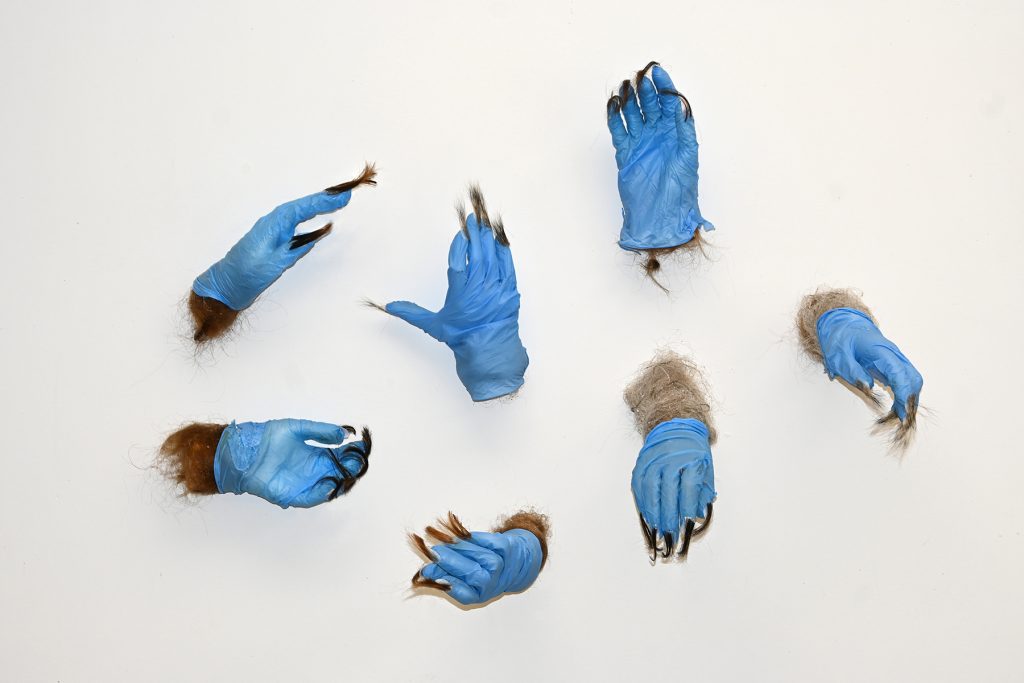
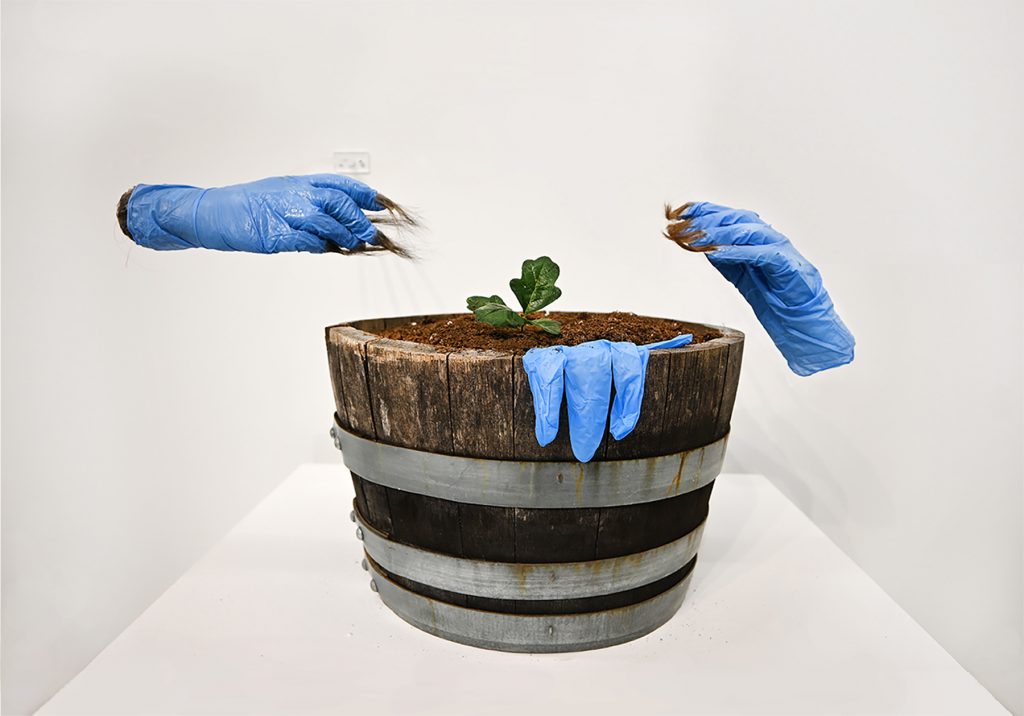
Carollyne Yardley, Rituals of Care (detail), from the Sympoetics of Squirrealism series, 2021. Garry oak seedling grown from foraged acorns, soil and oak barrel from garden (14″ x 9″ x 9″), gifted human hair, foraged used blue nitrile gloves, resin, acrylic nails, armature 25″ x 25″ x 36″, (each hand 10″ x 3″ x 4″). Installation in Becoming (Final Thesis Exhibition), Emily Carr University, 2021. Photograph by Carollyne Yardley.
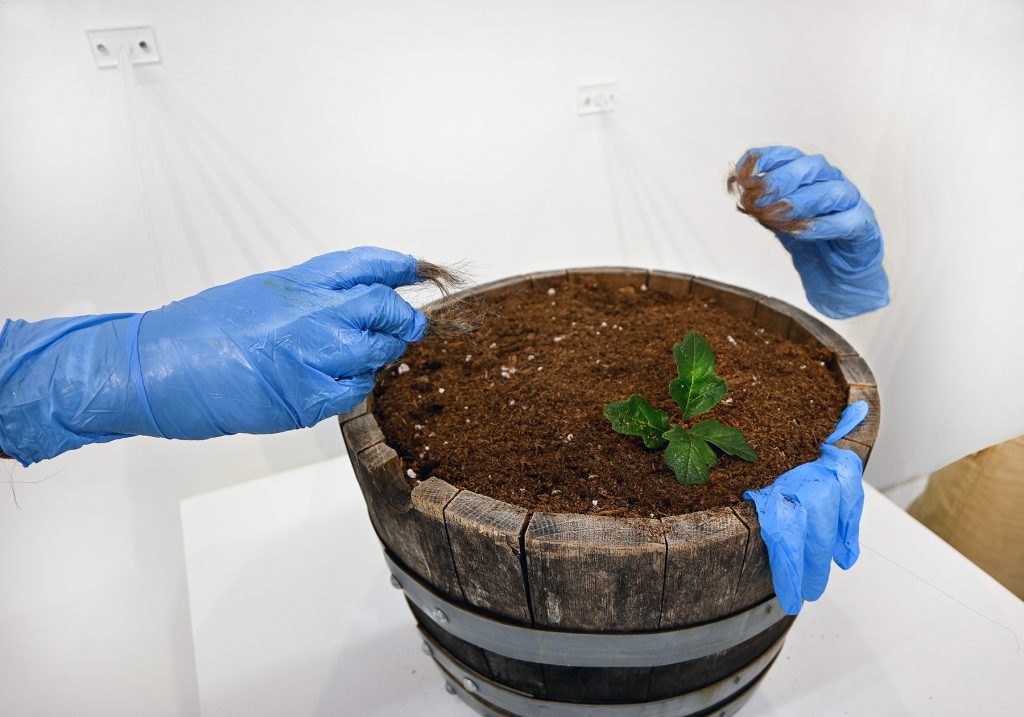
Carollyne Yardley, Rituals of Care (detail), from the Sympoetics of Squirrealism series, 2021. Garry oak seedling grown from foraged acorns, soil and oak barrel from garden (14″ x 9″ x 9″), gifted human hair, foraged used blue nitrile gloves, resin, acrylic nails, armature 25″ x 25″ x 36″, (each hand 10″ x 3″ x 4″). Installation in Becoming (Final Thesis Exhibition), Emily Carr University, 2021. Photograph by Carollyne Yardley.
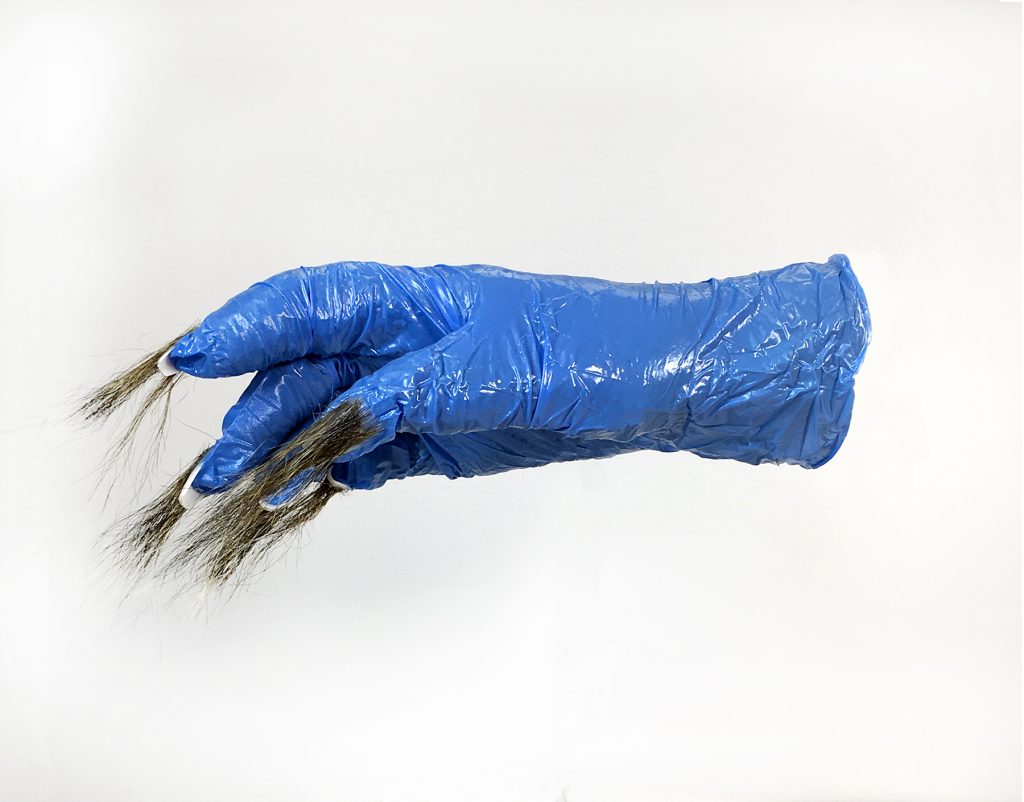
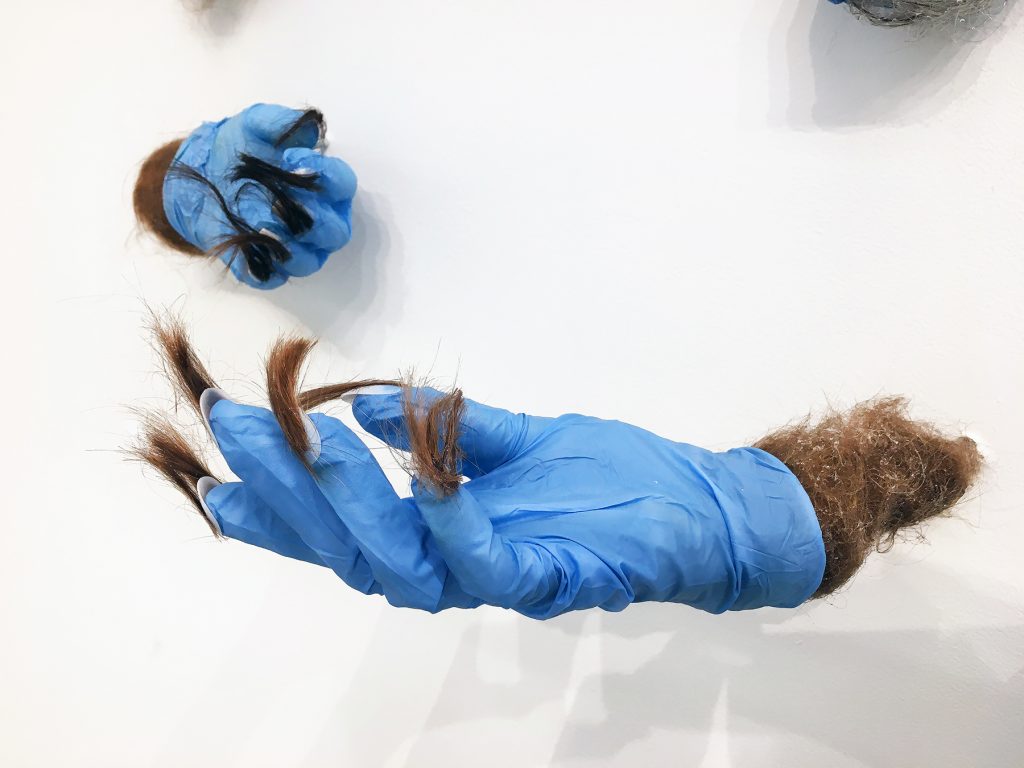
With much gratitude to my supervisor Dr. Randy Lee Cutler for her guidance and wisdom, and my internal Magnolia Pauker, and external Dr. Natalie Loveless. I’m thrilled to share with you BECOMING – A Thesis Exhibition by the Emily Carr University of Art + Design 2021 Low Res MFA cohort which features an introduction by curator Lisa Baldissera. I invite you to read my MFA thesis, Sympoetics of Squirrealism at the link below.
Sympoetics of Squirrealism (2021), researches the ethology of grey squirrels[1] and their links to human systems to speculate possible futures in hybrid human development through artistic practice. What began with asking what grey squirrels can teach us about Western-centric ideas of taxonomy and supposed boundaries between species systems led to thinking about the matter of molecules we inhabit, inhabit us, move around and between us, and are made of us. I began creating art and thinking with grey squirrels after an interspecies boundary was crossed when I held an injured squirrel in my hands. The intimacy of the encounter touched me and evoked a desire to document my alliance to the squirrel through artwork—thus, Squirrealism was born. Squirrealism developed into a method of art-making that channels conceptual and material connections between species to think and make, as feminist philosopher Donna Haraway says, “sympoetically.”
Often, my process begins by channeling squirrel behaviour and drey (nest) making techniques by walking, foraging, and weaving together salvaged remnants composting in the soil around trees inhabited by grey squirrels to stimulate new thought. Intuition, touch, and chance figure into the process during foraging, and again in the studio through extrasensory perception called psychometry (a type of telepathy using my hands) to collaborate through the materials. I also activated Squirrealism by collecting and burying Garry oak acorns. Through this process, I have made important discoveries by creating artworks that forge critical links between life for urban nonhuman animals and global environmental concerns. The material-semiotic entanglements of the artworks are manifest through materials in a shared squirrel-human environment resulting as an artistic hybrid of new bodily forms through assemblage, photography, and installation.
The artworks for this thesis emerged through a series of seasonal projects and during the outbreak of the Covid-19 pandemic. The final thesis installation presents a portrait of squirrel-human sympoiesis that developed as experiments unfolded. By attuning with collecting, burying, and nest making behaviours, I aim to disrupt anthropomorphic assumptions and situate my human animality in a sympoetic relationship with squirrels. My artistic research also provides insight into thinking critically about biological entities temporally connected to settler colonial timelines and boundaries in an urban environment.
[1] The Eastern grey squirrel (Sciurus carolinensis) is endemic to eastern and central North America and is also an essential natural forest regenerator. Grey squirrels are native to what is colonially known as five Canadian provinces, but by crossing provincial boundaries, either by their own agency or by human intervention, they have been incorrectly associated with being an invasive species which makes them killable. After their historic range was destroyed by settler colonialism and replaced with extensive logging and land clearing, grey squirrels became known as synanthropes —species that carve out their existence within human-modified environments and are ecologically related to humans; they literally become with us (Yardley 10).
Work Cited
BECOMING: The Class of 2021
Becoming—to move from one state to another, from one condition to another—is the remarkable achievement of the work of the Graduate degree in Visual Art. For the graduates of 2021, whose programme began in 2019, this has meant much more: navigating the vicissitudes of a global pandemic, the intensification and seismic awareness of the Black Lives Matter movement alongside the further transformational work of what it means to develop a professional practice, at a distance from not only the co-hort of mentors, colleagues and friends and the support of technical assistance and institutional spaces, but from those experiences of daily proximity of everyday life, of relatives, friends, local colleagues and gallery spaces. This graduating class has had ‘becoming’ in its most transformational sense, at the centre of their work—they have been by necessity, resilient, resourceful and self-directed—arriving at an enlivening array and diversity of works.
Their ‘becoming’ has also included the development of a remarkable collegial empathy for one another through the profound support structure that emerged within the co-hort, demonstrating an additional area of achievement: a much needed and instructive methodology to address care and empathy as essential for a professional artistic practice in the 21st century. Working together remotely, from Ottawa to Whitehorse, from the Prairies to the West Coast, their exhibition, Becoming, reveals on every level—personal, artistic, professional—the exciting and inspiring expressions of transformational movement within each artist’s own unique vision and awareness.
* * *
In the work of both Valérie Chartrand and Carollyne Yardley, empathy is expressed in attention to a co-created cosmos, one in which interspecies awareness provides a lever in which to understand the co-constituted foundation of the world and to propose ethical futures through animal-human sympoiesis.
Yardley’s observation of the lives of grey squirrels who were in close proximity and highly observable as she stayed close to home during the pandemic, led her to discover their places of resilience—a biosphere where squirrels adaptation to urban life was on quiet display, as was their threatened nature as ‘vermin.’ Her work has also focussed, literally, on her own backyard in Victoria, during periods of lockdown, when she held an injured squirrel, thus beginning the attentional devotion which led to installation and sculptural works that respond to the squirrel’s threatened condition within an ever instrumentalizing and proscribed planetary hierarchy that values some lives over others. Through her sculpture and photography, Yardley invents an uncanny form of disruption to that hierarchy—a hybrid and intimate method of ‘thinking-with’ she has termed, Squirrealism.
Chartrand’s work explores the possibility for kinship with other species, to offer a possible response to urgent ecological conditions, specifically the loss of biodiversity and reduction in insect populations because of human intervention and climate change. Chartrand’s interest in directly exploring nature as well as scientific methods led to her careful analysis of the conditions of moths and spiders in this body of work. Confined at times to her home in Ottawa during the pandemic, Chartrand employed the interior biome that she shared with spiders and the subtle ways in which they suffered or were supported to thrive. These careful observances resulted in bookworks and sculptures, alongside the artist’s augmented reality web app, IntersecT. Photographic portraits of individual spiders suggest quasi-familial relations, while installation works explore their capacity for desire: for water, for life, for being—desires shared by creatures whose non-human/non-anthropomorphic appearances have historically invited withdrawal of care.
Both artists consider what constitutes a grieveable embodiment, their work extending care to those whose lives have historically resided outside of empathetic engagement, in order to challenge hierarchical structures which also drive colonial practices of global capitalism.
Suzanne Paleczny’s work explores how stories create us and how memory resides in the body by creating an experimental image-system through painting. Reorganizing her longstanding practice of portrait work, Paleczny instead relies on a seeking, tentative and fractured foundation for her paintings, by discovering an architecture guided by blind contour, shape and the exploration of colour as a structuring device. In opening up and fracturing the image plane to express her experience of witnessing and caring for vulnerable and aging parents—care which occurred and was coordinated by Paleczny and her family during the pandemic—the artist’s heightened awareness of the ephemeral nature of memory and autobiography are revealed. Emulating the synaptic processes of erasure and storage in the brain as centrifugal forces in the work, Paleczny’s paintings articulate how the condition of dementia also demonstrate the fragility of historical record and personal archive, of storytelling and self-narration.
Robert Morris tends to the history and sensorium of the body and its limits through material explorations realized through gestural sculptural works. Morris’s kinesthetic knowledge of materials was first experienced during his mentorship with Inuit elders, as he began a decades-long practice of kayak building, leaning about balance, buoyancy, fluidity and volume. Morris’s work fuses this knowledge with the behaviour of wood when shaped into form: responding with equal knowledge to the capacities of wood and the kinesthetic knowledge of the human body. In Becoming, his work also embraces his study of viewers themselves, whose movements animate his delicately articulated sculptures, which function as poised meditations, arriving ultimately at a poetics of space and form that affirms internal states of balance and of knowing.
Jennie Vallis’s knowing arises from her family experience as well as her lived experience, as a performer, set designer, sculptor and editor. Vallis, using the metaphor of the Obi, or sash which holds a kimono together, weaves her family experience of displacement and disenfranchisement during the Japanese internment through a series of interdisciplinary works. Combining feminist methods, historical archival research of female samurai, and her study of traditional Japanese armour and weaponry in museum collections, Vallis develops unique sculptural forms to articulate grace, power and presence. In her singular works and collaborative ventures—from Big Kitty Magazine, which she founded, to collaborative performance works, to the sculptural creation of her own personal armour—Vallis finds a language of transformation that both empowers and moves.
Benjamin Oswald’s exploration of sonics and ceramic sculpture proposes forms for close listening: porcelain vessels and figures weave a story of how aural attention might shape experience. Drawing on his earlier scientific training in sound and physics, Oswald’s elegant ethereal works suggest both spaces for silence as well as resonance; his experiments with different receptacles of sound suggest possibilities for how the body also functions as a listening vessel. By nesting textual messages within individual sculptures as well as inventing new templates for sound apparatuses, Oswald suggests that care and attention may be the necessary conduits for an urgent need: close listening directed intimately to one another, and across distances, to the larger world at hand.
In each artist’s works, we are invited into a cosmology, a space in which is contained the larger questions that have become central during the past two years: how can we respond to the call for care? What does it mean to be radically empathetic? How can we make space for one another, psychically and physically, while thinking-with, and attending to our longing to be in proximity—to not be at a distance? Becoming suggests a pathway, a process, a series of methods, for such transformations.
Lisa Baldissera



![Squirrealism: Psychometry (IIC) in artistic practice. [Online presentation] International Multispecies Methods Research Symposium, University of Saskatchewan, Saskatoon, Canada.](https://www.carollyne.com/wp-content/uploads/2023/06/Screen-Shot-2023-06-18-at-9.16.32-PM-copy-1.jpg)

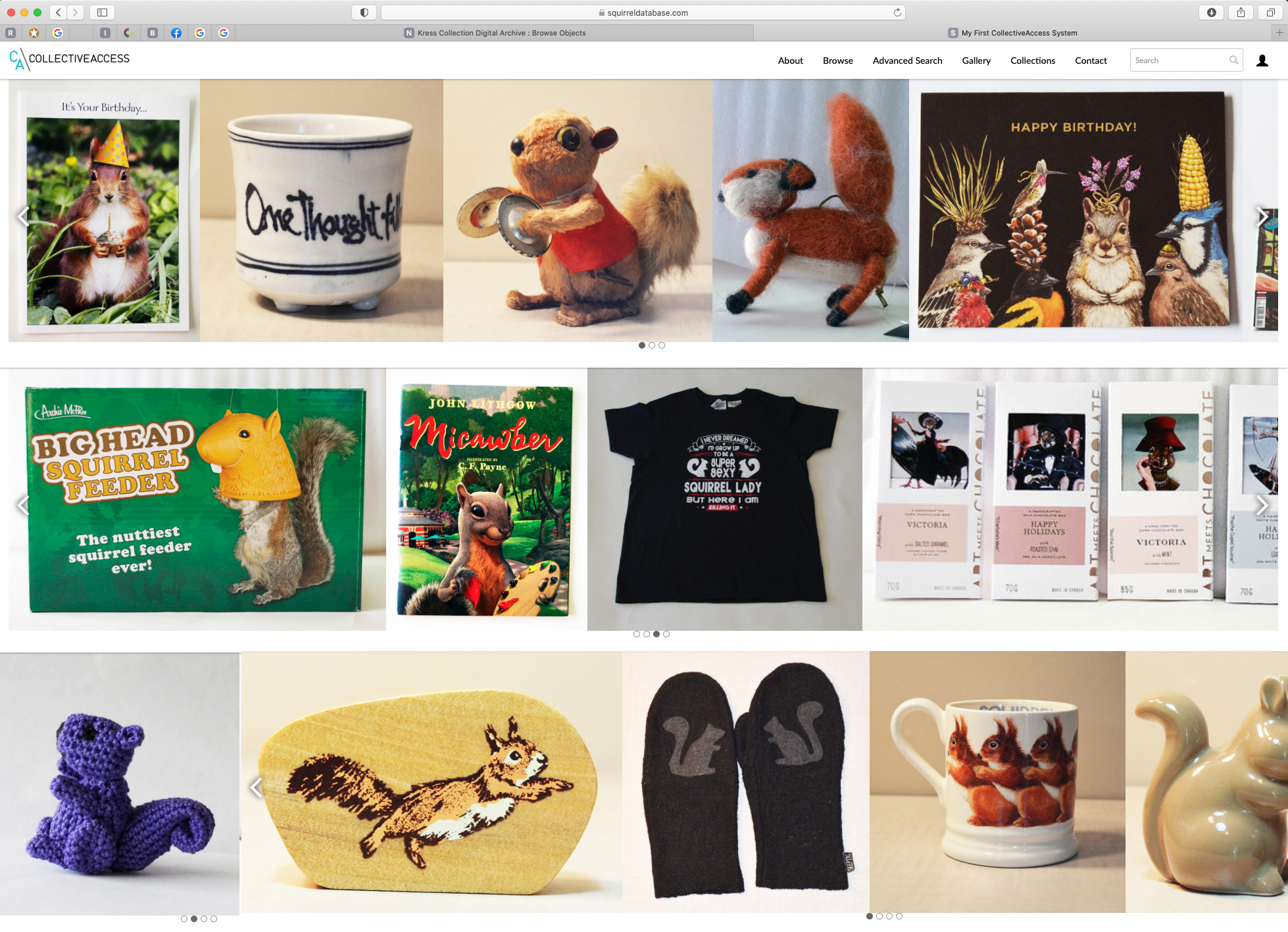

Get Social